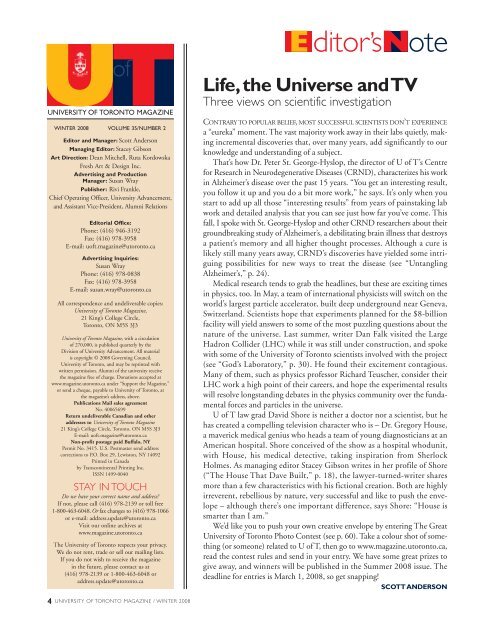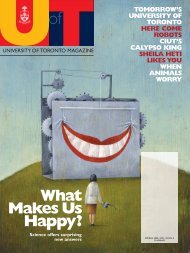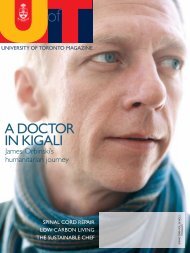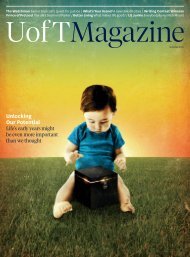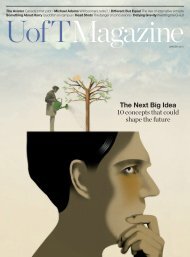THE HOUSE THAT DAVE BUILT - University of Toronto Magazine
THE HOUSE THAT DAVE BUILT - University of Toronto Magazine
THE HOUSE THAT DAVE BUILT - University of Toronto Magazine
You also want an ePaper? Increase the reach of your titles
YUMPU automatically turns print PDFs into web optimized ePapers that Google loves.
U<strong>of</strong>T UNIVERSITY OF TORONTO MAGAZINE<br />
WINTER 2008 VOLUME 35/NUMBER 2<br />
Editor and Manager: Scott Anderson<br />
Managing Editor: Stacey Gibson<br />
Art Direction: Dean Mitchell, Ruta Kordowska<br />
Fresh Art & Design Inc.<br />
Advertising and Production<br />
Manager: Susan Wray<br />
Publisher: Rivi Frankle,<br />
Chief Operating Officer, <strong>University</strong> Advancement,<br />
and Assistant Vice-President, Alumni Relations<br />
Editorial Office:<br />
Phone: (416) 946-3192<br />
Fax: (416) 978-3958<br />
E-mail: u<strong>of</strong>t.magazine@utoronto.ca<br />
Advertising Inquiries:<br />
Susan Wray<br />
Phone: (416) 978-0838<br />
Fax: (416) 978-3958<br />
E-mail: susan.wray@utoronto.ca<br />
All correspondence and undeliverable copies:<br />
<strong>University</strong> <strong>of</strong> <strong>Toronto</strong> <strong>Magazine</strong>,<br />
21 King’s College Circle,<br />
<strong>Toronto</strong>, ON M5S 3J3<br />
<strong>University</strong> <strong>of</strong> <strong>Toronto</strong> <strong>Magazine</strong>, with a circulation<br />
<strong>of</strong> 270,000, is published quarterly by the<br />
Division <strong>of</strong> <strong>University</strong> Advancement. All material<br />
is copyright © 2008 Governing Council,<br />
<strong>University</strong> <strong>of</strong> <strong>Toronto</strong>, and may be reprinted with<br />
written permission. Alumni <strong>of</strong> the university receive<br />
the magazine free <strong>of</strong> charge. Donations accepted at<br />
www.magazine.utoronto.ca under “Support the <strong>Magazine</strong>,”<br />
or send a cheque, payable to <strong>University</strong> <strong>of</strong> <strong>Toronto</strong>, at<br />
the magazine’s address, above.<br />
Publications Mail sales agreement<br />
No. 40065699<br />
Return undeliverable Canadian and other<br />
addresses to <strong>University</strong> <strong>of</strong> <strong>Toronto</strong> <strong>Magazine</strong><br />
21 King’s College Circle, <strong>Toronto</strong>, ON M5S 3J3<br />
E-mail: u<strong>of</strong>t.magazine@utoronto.ca<br />
Non-pr<strong>of</strong>it postage paid Buffalo, NY<br />
Permit No. 3415. U.S. Postmaster send address<br />
corrections to P.O. Box 29, Lewiston, NY 14092<br />
Printed in Canada<br />
by Transcontinental Printing Inc.<br />
ISSN 1499-0040<br />
STAY IN TOUCH<br />
Do we have your correct name and address?<br />
If not, please call (416) 978-2139 or toll free<br />
1-800-463-6048.Or fax changes to (416) 978-1066<br />
or e-mail: address.update@utoronto.ca<br />
Visit our online archives at<br />
www.magazine.utoronto.ca<br />
The <strong>University</strong> <strong>of</strong> <strong>Toronto</strong> respects your privacy.<br />
We do not rent, trade or sell our mailing lists.<br />
If you do not wish to receive the magazine<br />
in the future, please contact us at<br />
(416) 978-2139 or 1-800-463-6048 or<br />
address.update@utoronto.ca<br />
4 UNIVERSITY OF TORONTO MAGAZINE / WINTER 2008<br />
E ditor’sNote<br />
Life,the Universe and TV<br />
Three views on scientific investigation<br />
CONTRARY TO POPULAR BELIEF, MOST SUCCESSFUL SCIENTISTS DON’T EXPERIENCE<br />
a “eureka” moment. The vast majority work away in their labs quietly, making<br />
incremental discoveries that, over many years, add significantly to our<br />
knowledge and understanding <strong>of</strong> a subject.<br />
That’s how Dr. Peter St. George-Hyslop, the director <strong>of</strong> U <strong>of</strong> T’s Centre<br />
for Research in Neurodegenerative Diseases (CRND), characterizes his work<br />
in Alzheimer’s disease over the past 15 years. “You get an interesting result,<br />
you follow it up and you do a bit more work,” he says. It’s only when you<br />
start to add up all those “interesting results” from years <strong>of</strong> painstaking lab<br />
work and detailed analysis that you can see just how far you’ve come. This<br />
fall, I spoke with St. George-Hyslop and other CRND researchers about their<br />
groundbreaking study <strong>of</strong> Alzheimer’s, a debilitating brain illness that destroys<br />
a patient’s memory and all higher thought processes. Although a cure is<br />
likely still many years away, CRND’s discoveries have yielded some intriguing<br />
possibilities for new ways to treat the disease (see “Untangling<br />
Alzheimer’s,” p. 24).<br />
Medical research tends to grab the headlines, but these are exciting times<br />
in physics, too. In May, a team <strong>of</strong> international physicists will switch on the<br />
world’s largest particle accelerator, built deep underground near Geneva,<br />
Switzerland. Scientists hope that experiments planned for the $8-billion<br />
facility will yield answers to some <strong>of</strong> the most puzzling questions about the<br />
nature <strong>of</strong> the universe. Last summer, writer Dan Falk visited the Large<br />
Hadron Collider (LHC) while it was still under construction, and spoke<br />
with some <strong>of</strong> the <strong>University</strong> <strong>of</strong> <strong>Toronto</strong> scientists involved with the project<br />
(see “God’s Laboratory,” p. 30). He found their excitement contagious.<br />
Many <strong>of</strong> them, such as physics pr<strong>of</strong>essor Richard Teuscher, consider their<br />
LHC work a high point <strong>of</strong> their careers, and hope the experimental results<br />
will resolve longstanding debates in the physics community over the fundamental<br />
forces and particles in the universe.<br />
U <strong>of</strong> T law grad David Shore is neither a doctor nor a scientist, but he<br />
has created a compelling television character who is – Dr. Gregory House,<br />
a maverick medical genius who heads a team <strong>of</strong> young diagnosticians at an<br />
American hospital. Shore conceived <strong>of</strong> the show as a hospital whodunit,<br />
with House, his medical detective, taking inspiration from Sherlock<br />
Holmes. As managing editor Stacey Gibson writes in her pr<strong>of</strong>ile <strong>of</strong> Shore<br />
(“The House That Dave Built,” p. 18), the lawyer-turned-writer shares<br />
more than a few characteristics with his fictional creation. Both are highly<br />
irreverent, rebellious by nature, very successful and like to push the envelope<br />
– although there’s one important difference, says Shore: “House is<br />
smarter than I am.”<br />
We’d like you to push your own creative envelope by entering The Great<br />
<strong>University</strong> <strong>of</strong> <strong>Toronto</strong> Photo Contest (see p. 60). Take a colour shot <strong>of</strong> something<br />
(or someone) related to U <strong>of</strong> T, then go to www.magazine.utoronto.ca,<br />
read the contest rules and send in your entry. We have some great prizes to<br />
give away, and winners will be published in the Summer 2008 issue. The<br />
deadline for entries is March 1, 2008, so get snapping!<br />
SCOTT ANDERSON


